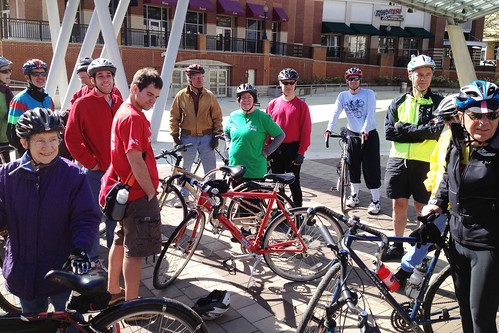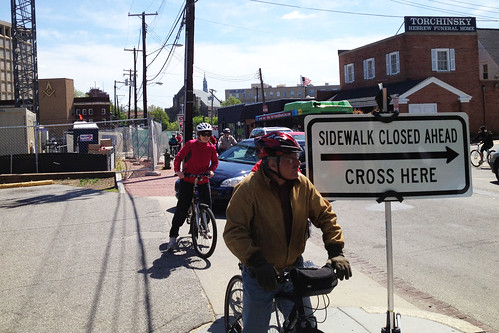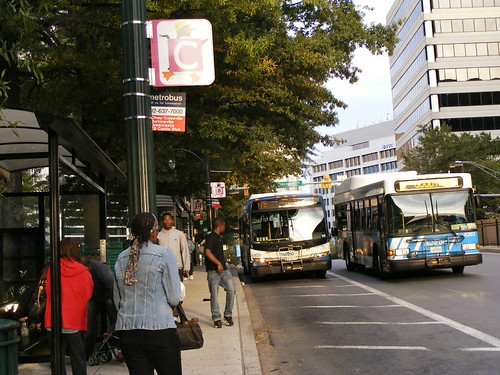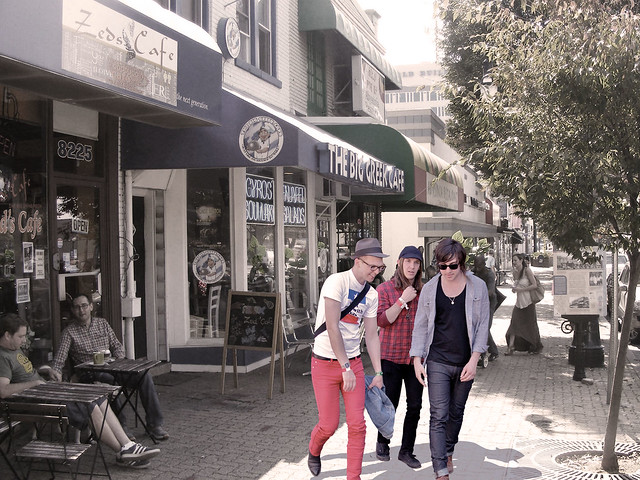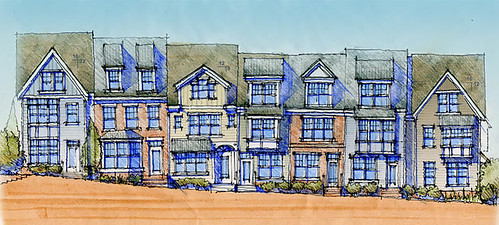 |
| This will actually get built. |
Yesterday, Montgomery County Planning Board unanimously voted to approve the controversial Chelsea Court townhouse development near downtown Silver Spring. The vote ends a 3-year fight between local builder EYA and a group of neighbors who said the project was too dense and would harm the environment.
The vote allows EYA to build 63 townhouses, including 8 moderately priced dwelling units for low-income households, and restore a historic house on the site of the Chelsea School, located on Pershing Drive one block north of downtown Silver Spring. The private, special-needs school first announced their plans to close and sell their 5-acre campus in May 2010. Most of the private, special-needs school's students live in the District or Prince George's County, and administrators want to focus on teaching them at public schools closer to home.
History of neighborhood opposition
 |
| Current site plan of Chelsea Court. |
Neighbors in the surrounding Seven Oaks-Evanswood Citizens Association, or SOECA, have strongly opposed Chelsea Court from the beginning. They worried about traffic and density and said that townhouses didn't belong in a "single-family neighborhood", especially when the property was only zoned for single-family homes.
The Planning Board approved a rezoning for townhouses in 2011, but it was rejected by the County Council, who said EYA's proposal for 77 homes was too dense. The Council eventually granted the rezoning for a reduced number of houses last year. Neighbor Thomas DeCaro filed a suit against the county saying they acted illegally, but the case was dismissed.
More recently, SOECA argued that Chelsea Court violates state and county environmental laws. A consultant hired by the neighborhood says EYA ignored Environmental Site Design requirements to preserve natural features. Opponents say cutting down the property's mature trees and removing its steep slopes will cause runoff into a stream buried below Ellsworth Drive.
In a letter to County Councilmember Valerie Ervin, SOECA president Jean Cavanaugh urged her to "take all steps necessary" to ensure that Chelsea Court incorporated ESD "without regard to the possible loss of development intensity."
However, officials from the county's Department of Permitting Services say the site's natural slope was already removed to create sports fields for the school decades ago. "I understand that you may not agree and that you have expressed significant opposition to the project," replied DPS director Diane Schwartz-Jones. "In our opinion, the applicant has complied with the standards spelled out in the Montgomery County Code and with [Maryland Department of the Environment] standards."
EYA willingly makes changes
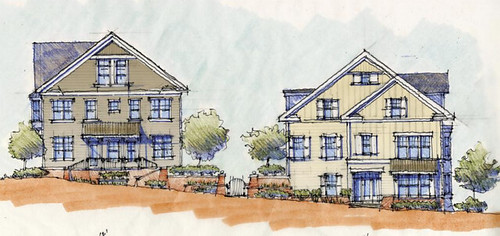 |
| Townhouses at Chelsea Court will be designed to resemble adjacent single-family homes. |
According to this planning staff report, EYA's latest design includes several changes in response to neighbor concerns. They've agreed to provide more parking than required, move a private road serving the new houses and restrict turns to or from it to discourage through traffic in a neighborhood where most streets are already blocked off.
In keeping with existing houses in the neighborhood, EYA's townhomes will be only 2 or 3 stories tall, as opposed to the 4-story homes they normally build elsewhere. Townhouses facing Springvale Road will be designed to look like single-family homes in order to blend in with existing homes across the street, while a double row of trees will shield them from sight.
Meanwhile, 51% of the property will be preserved as open space, including small courtyards between the rows of houses and two pocket parks. This figure also includes the private yard of the 150-year-old Riggs-Thompson House, which is currently being used by the school and will be turned back into a single-family house. Planners say this counts because the house's yard contributes to "a general appearance of openness."
At yesterday's meeting, 18 residents gave testimony about the project, including several supporters who noted EYA's responsiveness to their suggestions. "I'm pleased to see what EYA has crafted and look forward to the development coming to fruition," said Robert Bacon, who lives a few blocks away.
More density in Silver Spring is environmentally and economically sustainable
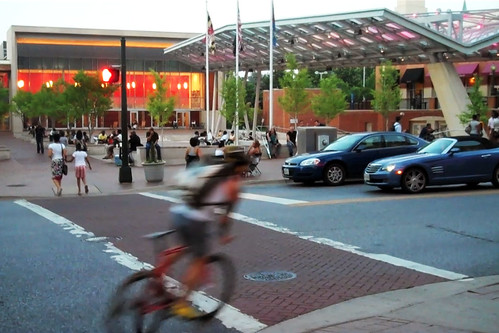 |
| Allowing more people to live near downtown Silver Spring is the "green" solution. |
It's not surprising that neighbors don't want to see trees cut down to build Chelsea Court, but this property isn't a virgin forest. It's a school campus that's already been cleared and built on. Building here is the environmentally responsible thing to do because it reduces the pressure to build in actual environmentally sensitive areas.
Chelsea Court is also located in an urban area a short walk from one of the region's biggest jobs, shopping and transit hubs. 60% of downtown Silver Spring residents already get to work without a car. Meanwhile, an independent study of EYA developments, including ones in Silver Spring, found that their residents walk more and drive less. Building more homes here means more people get to do the same, reducing their energy use.
But for all of the environmental benefits of being here, Silver Spring is an increasingly expensive place to live, due to the high cost of land and the expense of a 3-year-long permitting process. At an Urban Land Institute talk last summer, EYA partner AJ Jackson said that the time and money they've spent trying to get Chelsea Court built could add $50,000 to the price of each home.
Neighbors might say that maximizing density means bigger profits for EYA, but in reality, it means EYA can spread the cost of land and permitting over more homes, making them less expensive. $50,000 may not seem like a lot, but it means fewer people can afford to live in Silver Spring.
While people deserve a say in what happens in their community, the bitter and vitriolic fight over Chelsea Court sets a bad example for future projects. Not only does it create bad blood, but it encourages destructive suburban sprawl and makes Silver Spring a less affordable place to live.
We have to find a way to have a constructive dialogue about development, because this community's going to grow and change whether we like it or not. In the meantime, Chelsea Court has been approved. Not everyone will be happy with the Planning Board's decision, but they made the right one. Now it's time to get this project built.

